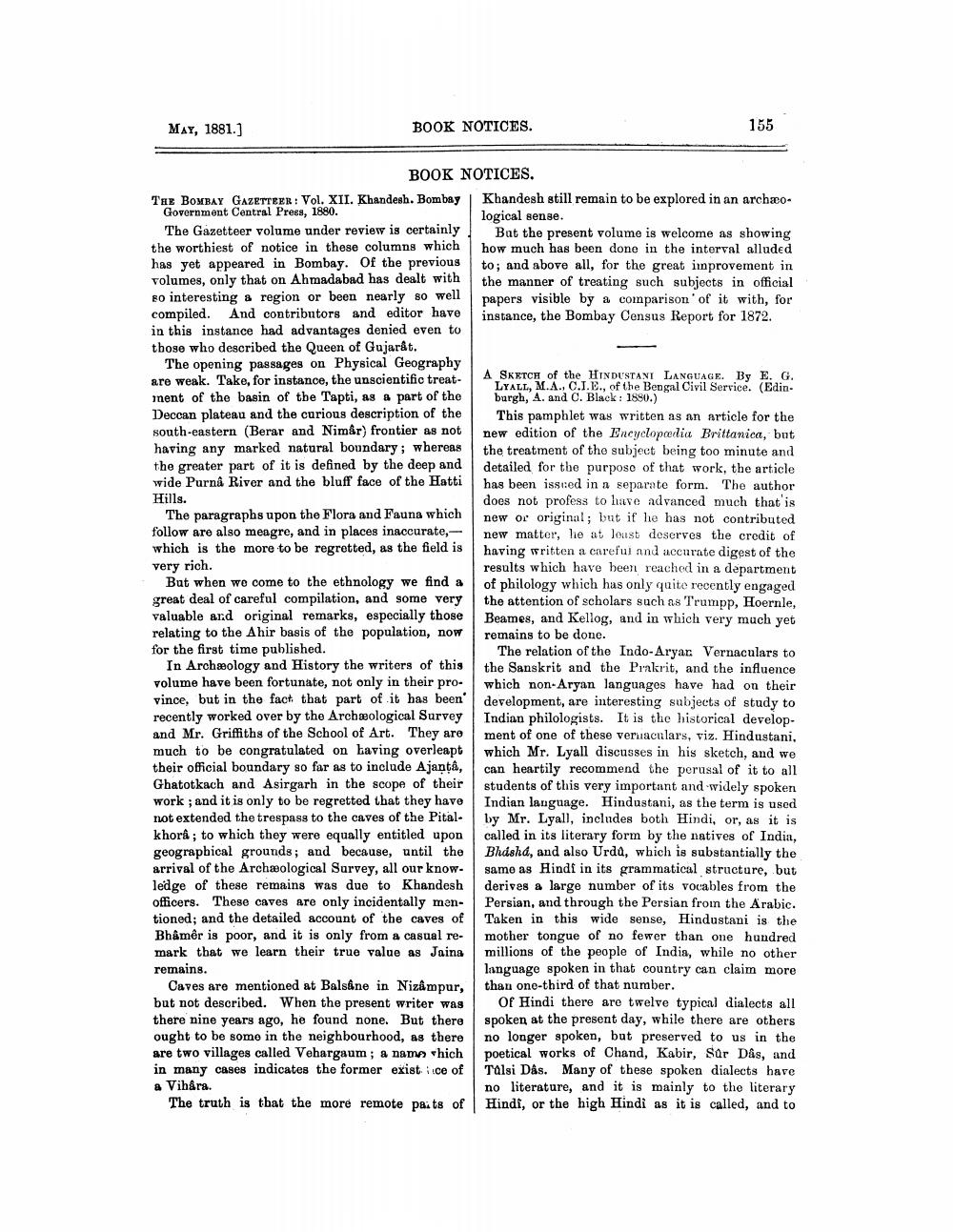________________
MAY, 1881.]
BOOK NOTICES.
155
BOOK NOTICES. THE BOMBAY Gazetteer: Vol. XII. Khandesh. Bombay | Khandesh still remain to be explored in an archæoGovernment Central Press, 1880.
logical sense. The Gazetteer volume under review is certainly Bat the present volume is welcome as showing the worthiest of notice in these columns which how much has been done in the interval alluded has yet appeared in Bombay. Of the previous
to; and above all, for the great improvement in volumes, only that on Ahmadabad has dealt with
the manner of treating such subjects in official so interesting a region or been nearly so well papers visible by a comparison of it with, for compiled. And contributors and editor have instance, the Bombay Census Report for 1872. in this instance had advantages denied even to those who described the Queen of Gujarât.
The opening passages on Physical Geography are weak. Take, for instance, the unscientific treat
A SKETCH of the HINDUSTANI LANGUAGE. By E. G.
LYALL, M.A., C.I.E., of the Bengal Civil Service. (Edinment of the basin of the Tapti, as a part of the burgh, A. and C. Black : 1890.) Deccan plateau and the curious description of the This pamphlet was written as an article for the south-eastern (Berar and Nimår) frontier as not new edition of the Encyclopaedia Brittanica, but having any marked natural boundary; whereas
the treatment of the subject being too minute and the greater part of it is defined by the deep and
detailed for the purpose of that work, the article wide Purna River and the bluff face of the Hatti
has been issued in a separate form. The author Hills.
does not profess to have advanced much that is The paragraphs upon the Flora and Fauna which
new or original; but if he has not contributed follow are also meagre, and in places inaccurate,
new matter, he at least deserves the credit of which is the more to be regretted, as the field is having written a careful and accurate digest of the very rich.
results which have been reached in a department But when we come to the ethnology we find a of philology which has only quite recently engaged great deal of careful compilation, and some very the attention of scholars such as Trumpp, Hoernle, valuable and original remarks, especially those Beames, and Kellog, and in which very much yet relating to the Ahir basis of the population, now remains to be done. for the first time published.
The relation of the Indo-Aryan Vernaculars to In Archaeology and History the writers of this the Sanskrit and the Prakrit, and the influence volume have been fortunate, not only in their pro- which non-Aryan languages have had on their vince, but in the fact that part of it has been development, are interesting subjects of study to recently worked over by the Archaeological Survey Indian philologists. It is the historical developand Mr. Griffiths of the School of Art. They are ment of one of these vernaculars, viz. Hindustani, much to be congratulated on having overleapt which Mr. Lyall discusses in his sketch, and we their official boundary so far as to include Ajanta, can heartily recommend the perusal of it to all Ghatotkach and Asirgarh in the scope of their students of this very important and widely spoken work ; and it is only to be regretted that they have Indian language. Hindustani. as the term is ne not extended the trespass to the caves of the Pital. by Mr. Lyall, includes both Hindi, or, as it is khorâ; to which they were equally entitled upon called in its literary form by the natives of India, geographical grounds; and because, until the Bhasha, and also Urdd, which is substantially the arrival of the Archæological Survey, all our know. same as Hindt in its grammatical structure, but ledge of these remains was due to Khandesh derives a large number of its vocables from the officers. These caves are only incidentally men- Persian, and through the Persian from the Arabic. tioned; and the detailed account of the caves of Taken in this wide sense, Hindustani is the Bhâmêr is poor, and it is only from a casual re- mother tongue of no fewer than one hundred mark that we learn their true value as Jaina millions of the people of India, while no other remains.
language spoken in that country can claim more Caves are mentioned at Balsene in Nizâmpur, than one-third of that number. but not described. When the present writer was Of Hindi there are twelve typical dialects all there nine years ago, he found none. But there spoken at the present day, while there are others ought to be some in the neighbourhood, as there no longer spoken, but preserved to us in the are two villages called Vehargaum ; a name which poetical works of Chand, Kabir, Sar Dås, and in many cases indicates the former existi.ce of Talsi Dâs. Many of these spoken dialects have a Vihara.
no literature, and it is mainly to the literary The truth is that the more remote paits of Hindi, or the high Hindi as it is called, and to




